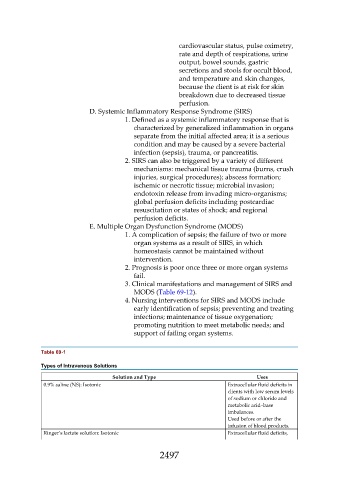Page 2497 - Saunders Comprehensive Review For NCLEX-RN
P. 2497
cardiovascular status, pulse oximetry,
rate and depth of respirations, urine
output, bowel sounds, gastric
secretions and stools for occult blood,
and temperature and skin changes,
because the client is at risk for skin
breakdown due to decreased tissue
perfusion.
D. Systemic Inflammatory Response Syndrome (SIRS)
1. Defined as a systemic inflammatory response that is
characterized by generalized inflammation in organs
separate from the initial affected area; it is a serious
condition and may be caused by a severe bacterial
infection (sepsis), trauma, or pancreatitis.
2. SIRS can also be triggered by a variety of different
mechanisms: mechanical tissue trauma (burns, crush
injuries, surgical procedures); abscess formation;
ischemic or necrotic tissue; microbial invasion;
endotoxin release from invading micro-organisms;
global perfusion deficits including postcardiac
resuscitation or states of shock; and regional
perfusion deficits.
E. Multiple Organ Dysfunction Syndrome (MODS)
1. A complication of sepsis; the failure of two or more
organ systems as a result of SIRS, in which
homeostasis cannot be maintained without
intervention.
2. Prognosis is poor once three or more organ systems
fail.
3. Clinical manifestations and management of SIRS and
MODS (Table 69-12).
4. Nursing interventions for SIRS and MODS include
early identification of sepsis; preventing and treating
infections; maintenance of tissue oxygenation;
promoting nutrition to meet metabolic needs; and
support of failing organ systems.
Table 69-1
Types of Intravenous Solutions
Solution and Type Uses
0.9% saline (NS): Isotonic Extracellular fluid deficits in
clients with low serum levels
of sodium or chloride and
metabolic acid–base
imbalances.
Used before or after the
infusion of blood products.
Ringer’s lactate solution: Isotonic Extracellular fluid deficits,
2497

